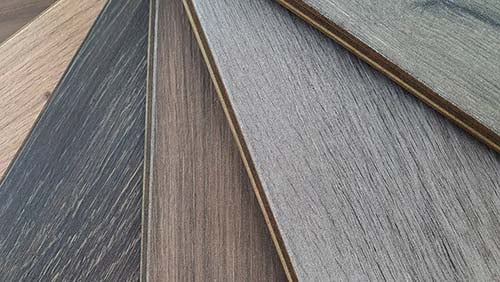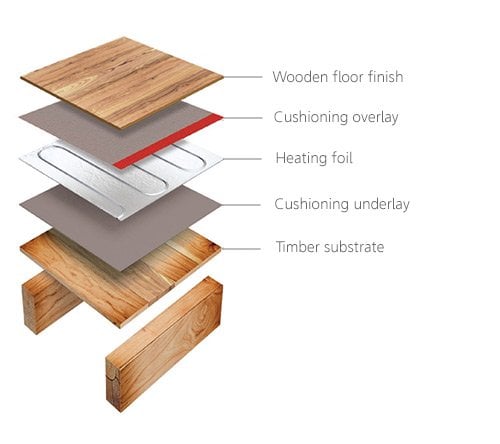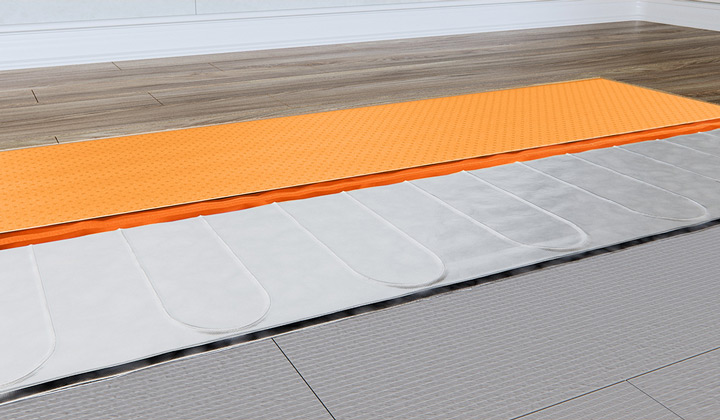7 min read
Guide to installing underfloor heating under wooden floors
Underfloor heating is well-known for warming cold tile and stone floors, but it can also make a wooden floor finish feel a million dollars. So, if...

What’s the best underfloor heating for wooden floors? The popularity of underfloor heating continues to rise for both new build and renovation projects. Typically installed under hard finished floors such as tiles or stone, there’s less understanding about installing underfloor heating in floors that will be finished with wood.
Fear not because if you are considering installing underfloor heating underneath a wooden floor for your next project, we’ve pulled together everything you need to consider before you fully commit. We’ll cover some top tips and considerations to ensure that, when finished, you are efficiently and effectively benefitting from the ideal underfloor heating installation.
However, if you want to skip this article and just want to ask an expert a question, you can contact our customer experience team who are always on hand to help. Simply get in touch via our contact page.
There are so many great reasons to install underfloor heating in your home. We’ve covered all of them with the electric heating blog but we’ll recap and summarise below which is specific to electric underfloor heating because that’s what we do! For more detailed information on wet underfloor heating, why not check out WMS who have a great amount of information on their website.
Heat that’s more comfortable: Underfloor heating produces radiant heat. It’s not that horrible dry heat like traditional central heating systems give. The humidity is kept in the air and the heat is distributed evenly throughout the space.
Unhindered design: No radiators on the wall means there’s much more wall space. So, you can place furniture where you want to complement your beautiful wooden floor.
Total control: By installing underfloor heating you can have total control on what rooms get heated and when. This level of control helps to conserve energy because you only heat up a space when you want to.
Superior efficiency: Underfloor heating works at much lower temperatures and when it comes to electric underfloor heating, it is 100% efficient at point of use because each joule of energy generated exactly where the heat is needed.
Green credentials: Underfloor heating is more efficient and as a result uses less energy. Electric heating will also be more favoured in SAP calculations when SAP 10 is released because it generates much less carbon emissions compared with gas alternatives such as traditional central heating.
Health benefits: Radiant heat reduces the amount of dust particles carried by the air which means inhaling it is much less likely. So, a great benefit for asthma sufferers. You can read the full list of health benefits in the ‘Can underfloor heating boost your health?’ blog post.
It certainly does. However, there are a few differences compared with a tile or stone finished floor.
Firstly, unlike tile or stone which are good conductors of heat, wood is an insulator and does not conduct heat as quickly as a ceramic tile, for example.
Just like hard floor finishes (tile or stone), a wooden floor distributes the heat in the room evenly which means no cold spots and no family feuds because everyone is trying to get the warmest spot in the room.

Generally, there are two different types of wooden flooring you can use with underfloor heating systems which are traditional solid timber flooring or engineered wood flooring.
Timber
Timber flooring is a natural hardwood which has been treated and cut into boards specifically to be used for flooring. If you are considering installing underfloor heating under a timber floor, quality matters. Narrow kiln-dried floorboards are the best fit because of the lower moisture content. The higher the moisture content the bigger the risk of the floor warping or bowing. Even from the cold Winters to the hot Summers, the temperature difference of the seasons can impact the floor. As always, installing a floor sensor with a reliable thermostat will ensure your beautiful timber floor will not overheat and get damaged.
We’ll discuss the recommended heat outputs a little further down in this blog.
Engineered Wood
Man-made and readily available, engineered wood has a solid hardwood timber finish with a plywood backing. It’s the laminated structure which allows for high quality engineered floors to withstand natural expansion and contraction effectively without compromising the efficiency of your underfloor heating system. All engineered wood is designed to limit the expansion and contraction caused by moisture in the atmosphere. In some instances, cheaper options can swell over time due to a softer core which absorbs more moisture. This swelling can cause a failure of the floor covering which will cost time and money to fix. Therefore, we always recommend that you consult the flooring manufacturer before fully committing to installing an underfloor heating system with their products.
One of the great things about engineered timber flooring is that it comes in a wide range of grain, patterns and sizes which helps to provide flexibility in the look and feel of the finished floor. Also, unlike natural timber, engineered wood floors can be installed at any floor level, including basements. So, if you are leaning towards an engineered wood floor, aim to get a board width of 160mm which is recommended for underfloor heating systems.

Moisture content
Wood naturally expands and contracts based its moisture content and will be affected by moisture from its surrounding environment. In other words, wood is hydroscopic. The moisture content of wood varies and it is best to choose the type of wooden floor that is best suited for the environment of your project. For example, natural solid timber floors can’t be used for basements as they are more susceptible to moisture related warping. A key consideration is width of board because wider boards will show more movement caused by expansion and contraction more than narrow boards.
It is important to remember that if the floor is installed incorrectly, it can significantly reduce the responsiveness of the underfloor heating system.
Conducting heat
It is generally recommended that a maximum restriction on floor surface temperature of 27°C should not be exceeded. This ‘ideal temperature’ is based on historic research exploring growth and shrinkage rates of timber floors and it was at 27°C that the expansion of timber tested was deemed ‘invisible’ to the eye. Even though this temperature is an industry-wide recommendation, we recommend that you contact the flooring manufacturers because there will be instances where the maximum temperature will vary.
What’s the ideal thickness of timber boards to use with underfloor heating?
The performance of underfloor heating can be impacted by the thickness and density of the timber floor. Wider timber boards will often show more movement than more narrow boards, it is recommended that the ratio of thickness to width should be in the range of 7 to 11. For example, a board with a thickness of 16mm and width of 160mm would give a ratio of 10, so that’s ideal!
 Great question! Both wet and electric underfloor heating systems will do a top job. However, when it comes to electric underfloor heating, there are particular systems that are more suited for heating wooden floors than others.
Great question! Both wet and electric underfloor heating systems will do a top job. However, when it comes to electric underfloor heating, there are particular systems that are more suited for heating wooden floors than others.
Foil systems are ideal for floating floor finishes such as wood. The heating cable is wrapped by two layers of foil which provides great thermal conductivity and fast heat up times. There are a variety of systems you can choose from Warm Up’s Foil Heater system to our very own ThermoSphere Foil. Even though many systems look very similar, there are subtle differences which make the efficiency and practicality of different systems better than others. This could include exposed cable loops for faster installation and if the heating mat is fully earthed.
So, when it comes to the best or most practical underfloor heating system to wet underfloor heating systems can do the job and do it well. But, if electric is more your thing, then we would recommend a Foil system which has specifically been designed for use with wooden floors.
Hopefully, this blog post has given you the information you need but as always, our team are on hand to help you further. Just head on over to the contact us page to start the conversation.

7 min read
Underfloor heating is well-known for warming cold tile and stone floors, but it can also make a wooden floor finish feel a million dollars. So, if...

4 min read
One of the most common questions that we get asked is ‘what is the best underfloor heating for timber floors?’ So, we’ve put this useful guide...

9 min read
If you are researching the feasibility of electric underfloor heating for your home, you may see a lot of examples that simply talk about underfloor...